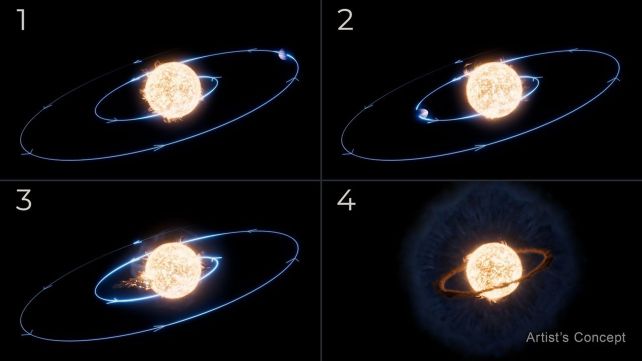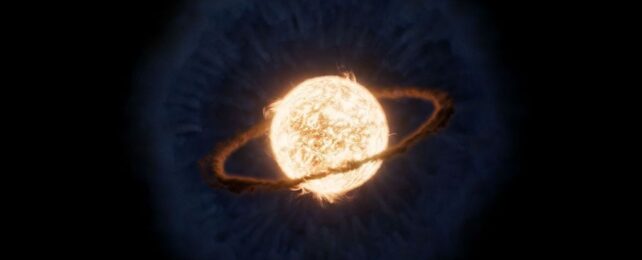A surprise twist has emerged in the tale of an exoplanet that was devoured by its star.
Rather than the star expanding to engulf the poor defenseless world, the world itself was complicit in its demise, falling in towards the star on a spiraling orbit of doom.
The finding, revealed through observations from JWST, offers some insight into the evolution of planetary systems, and the wild ways they can behave.
"Because this is such a novel event, we didn't quite know what to expect when we decided to point this telescope in its direction," says astronomer Ryan Lau of NOIRLab in the US.
"With its high-resolution look in the infrared, we are learning valuable insights about the final fates of planetary systems, possibly including our own."

The event first caught the attention of astronomers in 2020, when a star 12,000 light-years away suddenly blazed with light, brightening by a factor of 100 before rapidly fading again. By carefully analyzing all the possibilities, scientists concluded that the event, named ZTF SLRN-2020, could only be the result of a star scarfing down one of its exoplanets.
This is a Big Deal. It was the first time astronomers had observed a star devouring one of its orbiting worlds, opening what we thought was a window into the final stages of the life of a planetary system as a Sun-like star puffs up into a red giant and engulfs the exoplanets orbiting it.
"We are seeing the future of the Earth," astrophysicist Kishalay De of MIT's Kavli Institute for Astrophysics and Space Research said at the time.
Only, well, that turns out not to have been the case at all. Lau and his colleagues turned JWST's mid-infrared and near-infrared instruments to the star to reveal a completely different story.
When a star is just living its life, fusing atoms in its core to make heavier elements, it exists on the main sequence stage of a star's lifetime. When a Sun-like star starts to run out of its fuel, it puffs up into a red giant. It becomes hotter, brighter, larger: an unstable giant on the brink of death.
Any worlds within range would be toast; the Sun, scientists believe, might puff up as far as the orbit of Mars when it reaches the red giant phase in a few billion years.
However, when looking at the star responsible for ZTF SLRN-2020, JWST's mid-infrared instrument (MIRI) found that this star was nowhere near as bright as it should be if it was at the red giant phase. Rather, its brightness was consistent with a K-type star around 70 percent of the mass of the Sun, an orange dwarf with a main sequence lifespan up to 70 billion years.
In other words, it's a smallish, dimmish, coolish star that's still comfortably sitting on the main sequence. There's no puffing, there has been no puffing, and there will be no puffing for a long time. Which means that the exoplanet had to have died some other way.
There's a category of exoplanets out there that can explain it. A surprising number of 'hot Jupiters' exist in the Milky Way. These are Jupiter-sized worlds that are orbiting their stars extremely closely – too close to have been able to form there.
We have even seen hot Jupiters on such close orbits that they are evaporating, creating long tails of material as they whirl around their star. This could be one of the earliest stages of devourment: the exoplanet loses mass, its orbit decays further, and it ultimately slams into the star and dies.
This is what Lau and his colleagues think happened with ZTF SLRN-2020. A Jupiter-sized world was on a close orbit, closer than that of Mercury, that gradually decayed over millions of years, until it reached the point of total devastation.

"The planet eventually started to graze the star's atmosphere. Then it was a runaway process of falling in faster from that moment," says astronomer Morgan MacLeod of the Harvard-Smithsonian Center for Astrophysics and the Massachusetts Institute of Technology. "The planet, as it's falling in, started to sort of smear around the star."
Eventually, it disappeared into the star, leaving behind a puff of gas that cooled into cold molecular gas. Observations with NIRSpec revealed something unexpected, though. Closer to the star than the cool gas was a cloud of hot molecular gas that contained molecules such as carbon monoxide and phosphine.
The carbon monoxide, in particular, was interesting: it bore a powerful resemblance to the carbon monoxide seen in the planet-forming disks of dust that surround baby stars. What its presence at a planetary death means remains to be studied.
"This is truly the precipice of studying these events. This is the only one we've observed in action, and this is the best detection of the aftermath after things have settled back down," Lau says. "We hope this is just the start of our sample."
The research has been published in The Astrophysical Journal.
